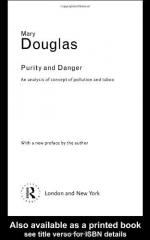
|
Chapter 1
• To understand and study purity and pollution, Douglas states that one must understand religious concepts.
• Frazer had contempt for primitive society and believed it lacked ethical refinement.
• Durkheim viewed rituals as being symbolic of social processes.
Chapter 2
• Flesh can transmit disease and has an overall toxic influence according to the beliefs of many cultures.
• Sumerian civilization used medical operations and procedures for purification.
• Douglas states that primitive cultures represent pattern rules, but modern cultures involve fragmented rules.
Chapter 3
• Douglas believes that holiness is the implication of separation.
• Blessing is the creation of order and prosperity with a lack of confusion, in Douglas' point of view.
• Categories of animals are designated and animals that don't act in accordance with the rest of their type are consider pollution.
Chapter 4
• Rituals were a part of primitive culture that embraced harmony, order, and meaning.
• Douglas states that rituals require sequentiality, faith...
|
This section contains 472 words (approx. 2 pages at 300 words per page) |

|




